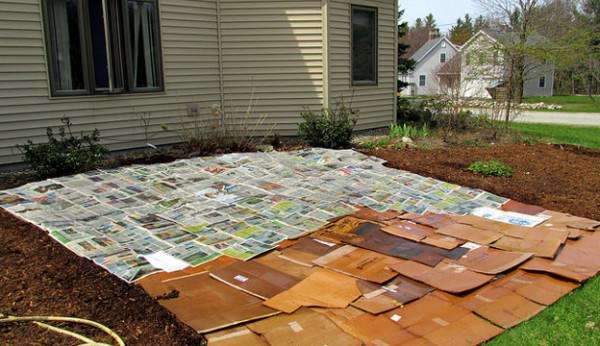
Sheet mulching – Issues and alternatives
Author : My Food Garden
Sheet mulching is a common practice recommended in permaculture. It uses cardboard and paper to smother the earth from growing weeds and grass whilst you attempt to build healthy soil on top of the cardboard and paper. My blog this month examines alternatives to sheet mulching which I feel are much more efficient and truly organic.
Much is written in permaculture material on the benefits of sheet mulching. In some permaculture forums, such as this one, problems with the sheet mulching methods are also expressed. Lets work through some concepts before getting into alternatives
Sheet mulching
- Removing organic matter – Step 1 with sheet mulching is to remove organic matter, in other words to smother weeds and grass with cardboard and paper so the growing space gets no light and those plants won’t grow.
- Adding organic matter – Step 2 with the sheet mulching is to add very large amounts of organic matter on top of the cardboard and paper. By adding organic matter, the ultimate goal is to build healthy soil
Seems rather odd when you break it down to these 2 points. I remember a few years ago looking around a very experienced permaculture person’s garden and he showed me his sheet mulching efforts in his orchard. These involved a cardboard base, deep layer of sugar cane mulch, another layer of cardboard and more mulch. I said to him, it seemed like a lot of work and materials and asked why he bothered when his garden space was already in one of the most fertile locations in Queensland. Basically I was saying why not improve the base soil rather than using effort and imported resources to create new soil.
Sheet mulching issues
- Introducing chemicals – The cardboard and newspaper introduce chemicals to the soil. Some of these chemicals are quite toxic. This forum thread on permies.com is insightful on chemicals in cardboard and newspaper. Also, check out a recent blog of mine about newspaper toxicity.
- Recycling contradictions – Sheet mulching does recycle cardboard, some is likely to not be from your use. This is OK if your key principle is to recycle, but then to keep this principle, you have to then bring in a lot of organic matter to build soil on top of it, so basically you are negating the benefits of recycling
- Ignoring the soil building nature of weeds – Weeds grow in soil to help with the soil healing process, to bring it into balance. Smothering weeds with cardboard ignores this fundamental process of nature. Instead of using what nature presents in your space, lots of work and materials (some toxic) are added to create soil, rather than working with nature’s process.
- Aesthetic – Cardboard and paper in a space are prone to get untidy and will take quite some time to disappear. If you have a big rain event much of the cover material will be washed off the cardboard. Beauty in a garden is a fundamental feature of its success.
Alternatives to sheet mulching
- Using weeds as resource – Your weeds reveal what is missing from the soil. By harvesting some of the weeds and turning them into a fermented tea, then applying this liquid back on the space, you speed up nature’s process. The success of this method can be improved significantly by using biodynamic compost preparations in the weed tea as these balance all the key mineral in the brew.
- Growing a living mulch – Within your orchard chipping away grass around your planting area and then seeding it with a plant that will benefit the trees and out-compete with other weeds and grasses, such as clover, is a highly efficient way to use a simple living process. In a vegetable garden, you could grow a cover crop or even multiple cover crops. These will change the living state of soil to suit your needs and reduce weeds and grass
- Re-mineralising the base – Getting your base tuned up with minerals is a big help. Low cost and easily accessible minerals such as gypsum, crushed basalt and wood ash always help
- Stimulating soil life – In working with the base soil to transform it, I have found biodynamic soil preparations highly efficient. Using liquid fertiliser you make is also helpful, such as comfrey tea, animal manure teas, seaweed teas, etc. Again, the biodynamic compost preparations in these teas improve their potency. Be sure to incorporate compost into your activity but you do not need a lot of compost, so long as you include regular planting of green manure crops (for vegetable gardens). The living process in the soil is also affected by planetary factors and timing your soil management activities in tune with the planets, increases the potency of your work. This is a key aspect with biodynamic methods
- Build a windrow compost heap – Built as your bed straight on top of the grass and weeds, this works well if you make a well structured compost heap.
- Light mulching – Mulch the soil appropriately during the year, but don’t mulch too heavily. In this way some weeds will grow and the space will show you what it needs through the weeds, so long as you make potentised weed teas
- Increase density of planting – By increasing your planting density in your vegetable gardens, you reduce the amount of light reaching the ground and the potential for weeds and grasses to grow. In addition, you get a lot more out of a small space
I hope you can see that food gardening without sheet mulching is very possible. Come along to one of our Workshops or talk to us about our Coaching service.
Happy gardening
Authored by Peter Kearney – www.beta.myfoodgarden.com.au

